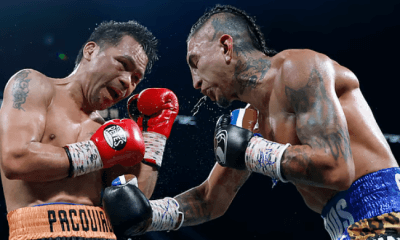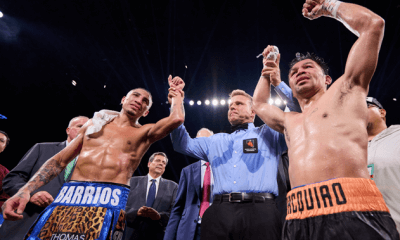Articles of 2006
The Case of Joe Mesi: Legality, Ethics and Self Determinism (Part I)
Joe Mesi will, in all likelihood, be returning to the professional punch for pay ranks in 2006.
For some, the return of the popular Buffalo, New York based heavyweight contender is justice finally served, the predicates of his medical suspension identified by the Nevada State Athletic Commission – the March 2004 MRI revelation of the fighter having suffered at least two subdural hematomas following his decision win over Vassiliy Jirov – no longer part of the fighter’s current ana
Others point to Mesi’s return fostering a dangerous precedent within the boxing world, namely fighters finding ways – even legal ones – to circumvent suspension based on manifest injuries suffered in the ring such as, though not exclusive to, bleeding on the brain, a condition once held to be a career ending threshold for a professional boxer.
As far as he was aware, NSAC Executive Director Marc Ratner believes Mesi’s legal petition to allow for him to move past his medical suspension and be free to apply for re-licensing as a professional fighter is a first. “It’s unprecedented for a fighter who’s suffered a subdural hematoma to be licensed again to fight.”
Of course, that is not to imply that all fighters who have suffered subdural hematomas have retired from the ring. It’s that fighters found to have suffered the trauma – having been diagnosed, with the malady made public to a licensing board – have not traditionally been allowed to fight again, notwithstanding that in boxing a statement made as a definitive, even in good faith, is essentially hyperbole. Mesi himself, seeking to break down the notion of definitive action into relativism observes, “you have to go case by case… this isn’t a black and white issue… each case, each person is different.” And here we run into a central axis for debate. Until Mesi's successful court challenge reversing what amounted to be a lifetime ban, suffering a subdural hematoma was thee threshold for effectively ending a fighter's professional career.
Once a fighter had been diagnosed to have suffered such an injury the implication of governance, the rationalizing implication, was seen as commonsensical, a given. The consequential nature of affliction meant the fighter in question was ‘prone’ to such injury, having already endured the trauma. So one’s medical history stood as a barometer defining one’s predisposition to such injury and all the weight of inferred probability seemed to confirm such belief.
And this is where the reality of disclosure and the tradition of no look/never tell intersect to form webs of contradictions and rationalizations. Of course, boxing and the limits of medical protection is sometimes characterized by contradictions and rationalizations. No one would ever assert that all fighters who have suffered subdural hematoma, be they acute, subacute or chronic, have retired from the sport. Most never knew of the phenomena, given the detection technology of medical resonance imagining and other diagnostic technologies are fairly recent inventions, compared with the total history of boxing. Even within the age of the current technological methodologies, most fighters do not have the finances to test themselves regularly; the Mesi case opens up waves of possible ramifications for boxing with respect to implied ethical practice: more on that later.
Can the sport, via its oversight bodies, in fact, protect itself as an entertainment platform and sporting activity if fighters can loophole themselves around sanctions? Is the right of the individual to pursue his own self-interest the trump card in this debate? Can oversight bodies act out preventative sanctions, if bounded by legal frameworks, to the infringement of individual liberties and the expectation of fair practice, while seeming to acknowledge due process? Yes, the issues are manifest, complex and perhaps represent the greatest debate in the sport for a generation.
The medical panel of the Nevada Athletic Commission voted in April, 2005 for a continuance of Mesi’s medical suspension, which was supported by the full voting body in June. The ruling prompted Mesi’s legal team to file a motion of appeal to the State of Nevada's 8th District Court. Because Nevada had suspended Mesi, due to Congressional law under the Muhammad Ali Boxing Reform Act of 2000, the ruling of the Nevada State Athletic Commission meant a national suspension within the United States, since all states uphold the disciplinary strictures of other states’ jurisdictions.
Mesi and his legal team also challenged the right (procedure) of the commission which shared (divulged) private medical information pertaining to Mesi with the media and outside entities, as part of the process of defining and defending their imposed medical suspension of the fighter. We should note that a medical suspension following the detection of a subdural hematoma is not disputed as a necessary safeguard procedure by Mesi, his legal team or anyone else in and around boxing. The question comes down to the legal boundaries of a commission or oversight committee with respect of suspending a fighter who has suffered such a condition, if after a reasonable interval the manifest signs and symptoms of the trauma have disappeared. As a governmental body charged with regulating the practice and parameters of the sport, can commissions (we include tribal bodies as well) act in a preventative way to safeguard the sport as a generalizing principle of ‘what’s in the best interest of the sport’; that too enters into the debate now that Team Mesi have navigated beyond the strictures of regulatory oversight and due caution, as is their legal right, as adjudicated in December.
For the undefeated Mesi, his position was that he’d been effectively barred from competition and the right to exercise his profession long after the need for a medical suspension was warranted. Thus, we come across the debate as to susceptibility. Since the summer of 2004, the concern for those that wish Mesi would stay inactive stems from the anecdotal and generalized fear that since he’s suffered this kind of brain bleeding he’s a walking time bomb. This remains the apprehension even with the disclosure in December of 2005 that currently Mesi is physically fit to box according to his doctors and numerous CAT scans he’s undergone.
“I took all the tests out there. I have said this before… all the requirements have been met. I'm healthy now… what more can I say?” was Mesi’s cryptic response to those that remain concerned for him.
The fight that put Mesi down almost for the count was a rugged affair with Vassiliy Jirov on March 13, 2004 at the Mandalay Bay. The rounds were heated and the exchanges withering. We note at this juncture that statistically speaking – and here we are relying on a Japanese study – most hematomas occur during 10 round fights. Mesi, boxing well for much of the contest, was dropped by a Jirov uppercut in the 10th round. He was up and soon down again, though he regained enough composure to hear the last bell, on his feet after taking a battering, and the judges scoring that had him taking a unanimous decision. But as we all know, the trauma was only beginning and Mesi hasn’t fought since.
Having suffered a diagnosed hematoma, pooling of the blood lying beneath the outer covering of the brain, the dura, and the brain’s surface, doesn’t equate to inordinate susceptibility according to the doctor’s retained by Mesi. Nor was their testimony to that effect substantially refuted by the NSAC and the doctors on its board at the time. Team Mesi’s legal argument came down to the fighter now being no more at risk of subdural hematoma than any other fighter.
The semantics of susceptibility and predisposition cannot be linked to the Mesi case as a defining element, that too was implied in the findings, as issued in the opinion of Clark County District Court Judge Douglas Herndon’s ruling, which noted, that since Mesi’s license had elapsed December 31 of 2004, the state regulating body had no authority to medically suspend Mesi in the state of Nevada.
The principle testimony of Dr. Robert Cantu, respected neurosurgeon from Massachusetts, Dr. Stephen Olvey and Dr. Julian Bailes, who consults for the NFL Players Association on head injuries, was determinative. According to their research and experience, Joe Mesi was no more likely to again suffer injury than any other fighter. That testimony was not effectively challenged.
We must remember the ‘political’ context of the Mesi suspension, as a tangential element for consideration. The boxing haven and Mecca of Nevada, reeling from the deaths of Martin Sanchez in July and WBC lightweight champion Leavander Johnson in September 2005, followed their regulations to the letter in medically suspending Mesi in light of the post-fight diagnosis of subdural hematoma, whether it was subacute or chronic, the distinction being determined by the time elapsed from the initiating trauma for the blood to collect. (Veins between the brain and the outer surface – the dura – are attenuated and rupture causing collections of blood in areas.) In following the letter of the state’s regulations the commission acted upon the letter and certainly the spirit of the law as written.
The one thing they didn’t want was another tragedy, the popularity of a figure like Joe Mesi being injured any time in the future of his career, in any state, was something no one connected to the NSAC wanted to live to see.
In pursuing his legal rights has Mesi opened the door to normalizing litigation seeking to challenge medical sanctions and suspensions in the future? Some in boxing fear it just might. If this is so, then how can boxing seek to govern/regulate itself with respect to controlling the ultimate conditions for participatory guidelines? Certainly boxers, of all people, don’t need to be reminded of the dangers inherent in taking undue risks. At least, one wouldn’t think so.
But if the law, the act of self regulation in boxing, is not in keeping with something commensurate to ethical imperatives respected, then how can it manifest anything like product integrity and the fostering of a healthy entertainment persona?
(End of Part 1)
-

 Featured Articles3 weeks ago
Featured Articles3 weeks agoThe Hauser Report: Zayas-Garcia, Pacquiao, Usyk, and the NYSAC
-

 Featured Articles2 weeks ago
Featured Articles2 weeks agoOscar Duarte and Regis Prograis Prevail on an Action-Packed Fight Card in Chicago
-

 Featured Articles1 week ago
Featured Articles1 week agoThe Hauser Report: Cinematic and Literary Notes
-

 Book Review5 days ago
Book Review5 days agoMark Kriegel’s New Book About Mike Tyson is a Must-Read
-

 Featured Articles4 weeks ago
Featured Articles4 weeks agoManny Pacquiao and Mario Barrios Fight to a Draw; Fundora stops Tim Tszyu
-

 Featured Articles4 weeks ago
Featured Articles4 weeks agoArne’s Almanac: Pacquiao-Barrios Redux
-

 Featured Articles3 weeks ago
Featured Articles3 weeks agoRemembering Dwight Muhammad Qawi (1953-2025) and his Triumphant Return to Prison
-

 Featured Articles4 weeks ago
Featured Articles4 weeks agoOleksandr Usyk Continues to Amaze; KOs Daniel Dubois in 5 One-Sided Rounds















